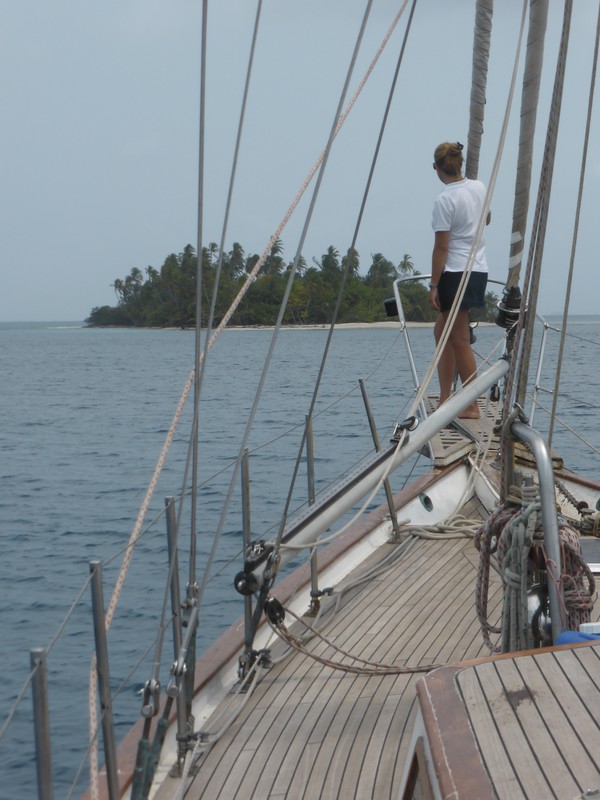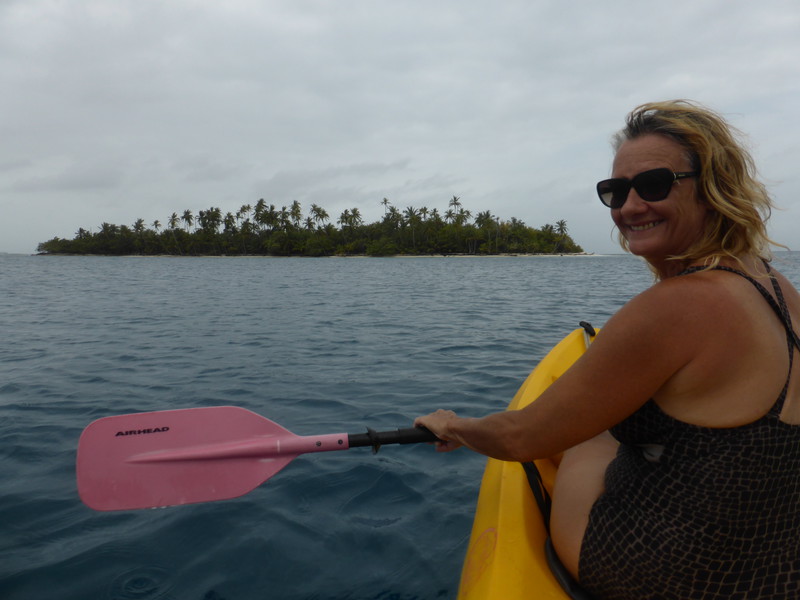
El Porvenir might be the capital of the San Blas archipelago, but it's not exactly the most beautiful place in the world; the island is home to an airstrip, a museum, an immigration office and a handful of buildings, and just next door is another island that is so crammed full of houses that they practically spill off the edges and into the ocean. It certainly isn't one of the idyllic islands that the San Blas is famous for, so although we'd gone to sleep in the ocean swell and had woken up anchored in the San Blas archipelago, as Jan had promised we would, we weren't in paradise quite yet.

It took four hours of gentle sailing to reach Cayos Holandeses, passing a string of tiny islands on the way, each of them sprouting so many palm trees that from a distance they looked for all the world like upturned scrubbing brushes floating on the waves. Some of them had little huts tucked away beneath the palm fronds, while others were completely deserted, but they were charming, and the only thing missing was sunshine and beautiful blue skies. Unfortunately the weather was rather overcast and a little grey, though this mercifully meant we were comfortable on deck, rather than being burned by the equatorial midday sun. The sailing, too, was easy, because the San Blas is far calmer than the open waters of the Caribbean Sea, as it's sheltered from the ocean swell by all the islands and reefs that fill the Gulf of San Blas.

Even with overcast skies, the Cayos Holandeses are a slice of paradise. It is, however, not an undiscovered paradise, as we found when we pulled into Swimming Pool anchorage, where we'd hoped to drop anchor for a couple of days. This anchorage, which sits between the islands of Morodup and Banedup, is famous for having wonderfully clear water, and the local Kuna take great pride in keeping the islands tidy and litter-free; Morodup is known by yachties as Barbecue Island, as it's a perfect spot for a barbie with its luscious golf-course grass, and sand that's regularly swept clean by the locals. Unfortunately the anchorage was absolutely rammed with yachts when we arrived, and when Jan took The Black Dragonfly into the middle of the throng, he soon realised that it just wasn't going to be safe to drop anchor this close to all these other boats. 'We need another plan,' he said as he swung around and headed back out the way we'd come; apparently at this time of year, quite a few yachts apply to go through the Panama Canal, but as boats are often given passage times a couple of weeks from their application date, quite a few of them decide to spend those weeks moored up in a paradise like Swimming Pool anchorage.

Luckily, just southwest of Morodup and Banedup, Jan found two more tiny little islands where he figured he could drop the anchor, and after some deft manoeuvring, The Black Dragonfly lay anchored in an idyllic sheltered spot, with no other yachts in sight. We had two pristine and totally uninhabited islands to explore, both of them within swimming distance (for strong swimmers like Marco and Stephan, anyway), and after we'd enjoyed a sumptuous tandoori chicken salad on deck, we piled into the dinghy and visited the southernmost island, which we walked around in a handful of minutes, snapping away at the perfect postcard pictures that seem to spring up at every corner when palm trees meet tropical beach.
Night Lights

That night, as we sat on deck after a hearty dinner of beef fajitas, enjoying a gin and tonic in the perfect isolation of our own private anchorage, the ocean put on a show that was completely unexpected. I first came across marine phosphorescence when I sailed the Pacific; sometimes, at night, the yacht's wake would leave an eerie blue glow in the water, and you could generate a glow yourself by stirring up the water, perhaps by throwing a line into the sea, or by answering the call of nature over the side of the boat. It helped to pass the long hours on night watch, looking for phosphorescence, which is caused by blooms of billions of bioluminescent phytoplankton which produce light when they're disturbed (which scientists think is a defence mechanism, as nobody wants to eat anything that glows).

But the phosphorescence that we saw over the side of the yacht on our first night in the San Blas was much more sophisticated than a simple glowing wake. In the water we could see alien lifeforms swimming in loops and arcs, leaving bright blue trails of light behind them in psychedelic patterns reminiscent of the spiral imprints left by ancient shells in fossil beds in the desert. They spun and curled beneath us like neon lights in a screensaver, but if we shone a torch on them, the lights disappeared and they looked like nothing more than small fish, flitting around in the torchlight. It seemed that the normal sea life round these parts was swimming through a cloud of bioluminescence, and all we were seeing was the glowing wake left by the darting passage of a fish, or the looping curves of an underwater worm corkscrewing through the shallows. At one time there must have been 40 or 50 glowing Catherine wheels of light around the boat, looking for all the world like stars reflecting in a busy sea, even though the sky was completely overcast. It was simply beautiful, and the display went on for a good hour before slipping gently back into the night.
Exploring the Holandeses

The next day we decided to explore our new neighbourhood, so Peta and I took the yellow plastic kayak that was strapped to the front deck of the yacht, and paddled round our northernmost neighbour. By this time the wind was picking up a bit and the skies were starting to darken, so the first trip against the wind and round the first corner was fairly choppy and involved a few light rain showers, but even in the rain there's still something perfect about kayaking round a desert island, while the beautiful curves of a 50ft ketch home in and out of view, with palm trees and pristine beaches as their backdrop. We pulled up onto the end of the island and had a quick poke around our very own island paradise, before heading back to The Black Dragonfly to grab our snorkelling gear.

Almost all of the islands in the San Blas have their own underwater reef systems, and indeed it's these reef systems that create the islands in the first place, as the reefs eventually grow large enough to start silting up with sand, until they eventually stick up above the waves where vegetation can take hold. The best way to explore an island's reef system is to work out where the current is coming from, and to start swimming into the current; in this way, if you get tired, you can easily drift back to where you started, rather than being carried further and further away from safety. Luckily, this meant we could jump out of the yacht and swim straight over to the island to reach the perfect starting point for an exploration of the reef jutting out of the eastern shore; so Peta and I spent an enjoyable hour floating through the coral canyons, spotting plenty of fish and lots of different formations, from coral fans to brain coral to big stacks of yellow fins. Even though the light wasn't perfect, it was very enjoyable.

That afternoon, after a lovely lunch of frittata with beetroot salad – I'm sorry to keep mentioning the food, but it really was exceptional – Jan took us in the dinghy to the southern island for a snorkelling trip, where there were plenty of fish just off the pristine beach at the western tip of the island. Our original plan had been to build a fire on that beach and have a bit of a beach party, but the clouds had gathered during the afternoon and they soon put a dampener on that idea, so after the snorkelling we all piled into the dinghy for an exploration of the channels and islands to the west of Swimming Pool anchorage. The islands are all slightly different in character and it's hard not to keep on taking photographs at every turn. There was one palm tree, hanging over the water, which was particularly photogenic... and which, it turned out, was the perfect height for those so inclined to climb up and hang off upside down, though we settled for having our picture taken while standing underneath.

Further along the island was a group of yacht captains who'd popped over from Swimming Pool anchorage, which was just next door, and while we curled our toes in the sand and took in the view of all the anchored yachts turning in the breeze together, the captains started comparing boat sizes in the way that males the world over are genetically obliged to do. Luckily the rain had other ideas and it soon forced us all back into our respective dinghies, and before long we were back in our 50ft Formosa, enjoying a perfectly cooked meal of salmon fillets in sundried tomatoes, with pasta and fresh green asparagus spears.
But we couldn't stay here forever, and the conversation soon drifted to the plans for tomorrow, which would involve a short hop south and east to Cayos Coco Banderos, the last stop before the ocean crossing to Colombia.